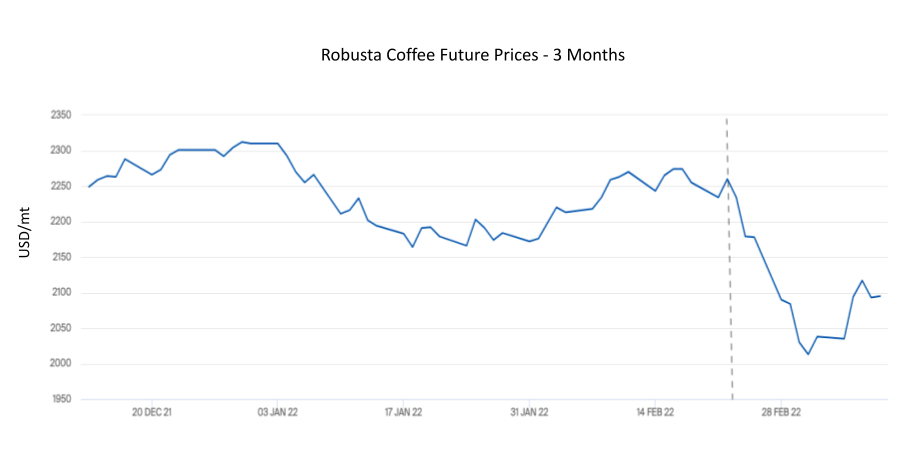Concerns Regarding Coffee Demand in Russia Push Down Future Prices

Throughout 2021, the coffee futures prices set record highs every week due to lower production in Brazil, the largest coffee-producing region of the world. Under normal business conditions, coffee stock and supply were expected to be low even in 2022, with forecasts that coffee futures prices would also continue to rise. The growing logistics prices and inflation were only going to inflate the prices more in 2022. On the contrary, during W4 of February and W1 of March 2022, the futures prices for arabica and Robusta fell to a 2-month low and 1-month low respectively. The sudden dip in prices can be attributed to the ongoing geopolitical tensions between Ukraine and Russia. A higher drop was seen in the future prices of Robusta than in Arabica, as the former is a more popular variety in Russia that is used for making instant coffee.

Source: ICE Futures.
Russia is an important market for coffee-exporting countries, as the country is among the fastest-growing coffee importers. The country imports coffee from a few main markets such as Vietnam, Italy, and Colombia. Recent sanctions imposed on Russia, however, have reduced the overall demand for coffee in the country, making trade difficult. In addition, Russian consumers are tightening their belts by limiting their visits to restaurants and cafes in anticipation of higher price inflation in the coming months. Furthermore, tensions have raised concerns regarding global inflation due to rising costs of energy and fuels. Furthermore, the price of metal, aluminum, and other packaging materials for coffee has increased. The overall cost of exports has gone up, resulting in lower demand among coffee traders across the world.
Concerns regarding limited demand for coffee in Russia and across the world pushed down the domestic price of coffee in Vietnam which is the leading exporter of instant coffee variety Robusta. According to Reuters, Vietnam's domestic coffee prices dipped in the W1 of March 2022 following a tumble in London prices amid disruptions in supply chain and payment methods. Vietnamese coffee traders are also concerned about the mode of payment, as Russia remains banned from many major international banking systems. Reuters reported that the largest coffee producing area in Vietnam sold coffee at USD 1.70-$1.80 per kg in W1, a WoW decline of at least 5%. As we moved towards W2 and W3 of March 2022, the coffee prices seem to have recovered from the sudden dip but are still way below the levels seen before the Russia-Ukraine conflict.






